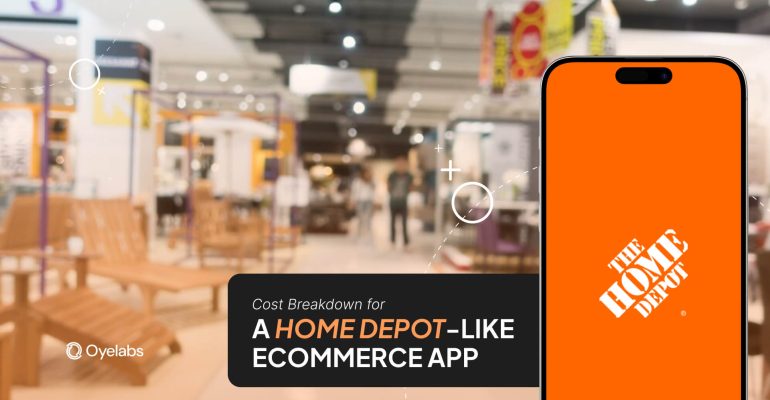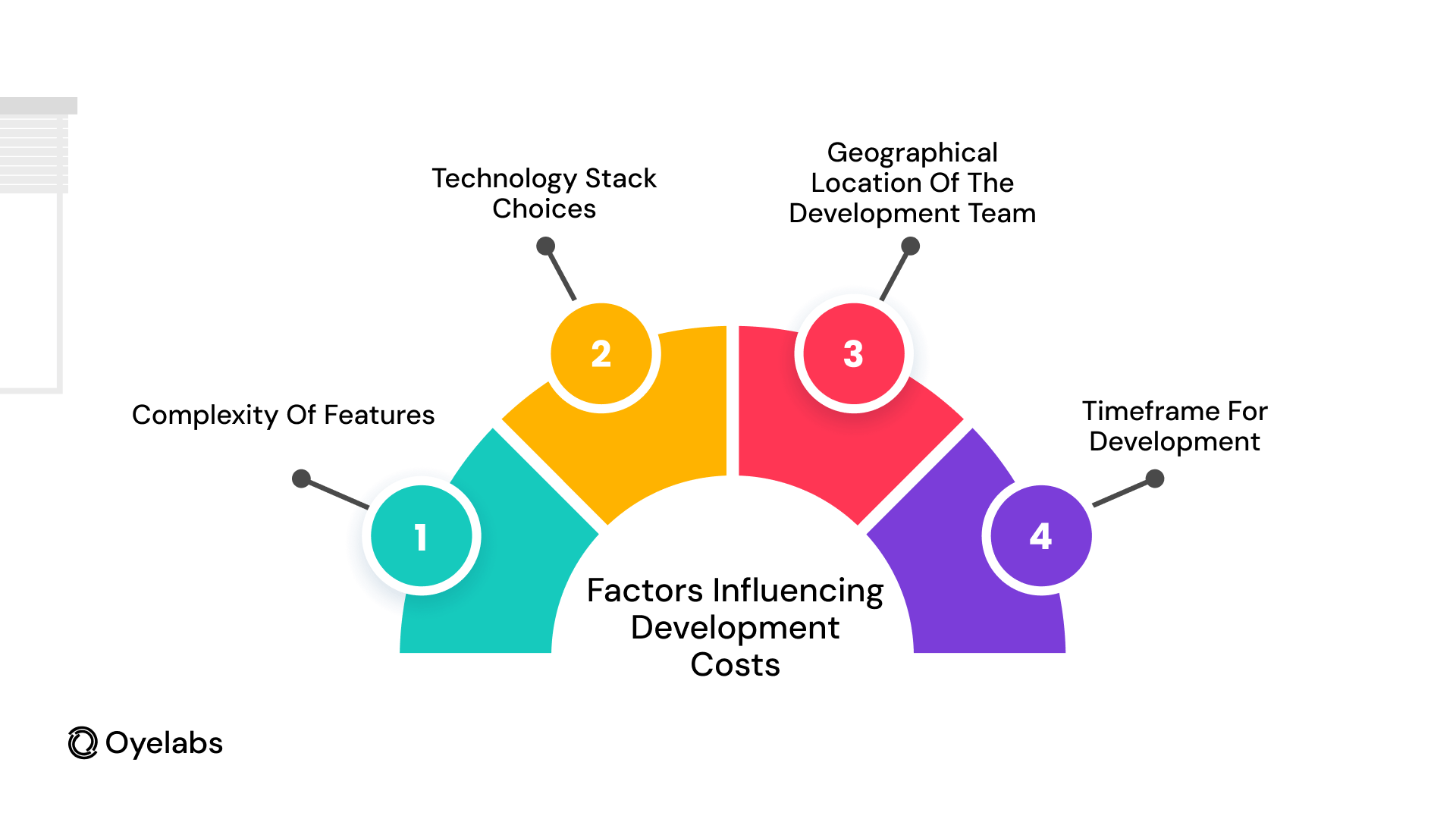Cost Analysis for Developing a Home Depot-Like App

Cost Analysis for Developing a Home Depot-Like App
Last Updated on October 26, 2024
A robust eCommerce app is essential for success in today’s competitive market, providing seamless shopping experiences that foster customer loyalty. Mobile consumers expect quick access, easy navigation, and secure payment options. An effective app addresses these needs by offering personalized experiences, integrating features like augmented reality for product visualization, and ensuring efficient customer support.
This blog offers a cost analysis for developing an eCommerce app similar to Home Depot, examining initial development and ongoing maintenance expenses. Additionally, we will discuss key features for success and the factors influencing costs, providing valuable insights for businesses entering the eCommerce space. If you plan to launch your own Home Depot-like app, consider Oyelabs’ eCommerce app development services.
Importance of a Robust App
The global eCommerce market is expected to reach approximately $5.55 trillion in 2024, with a projected growth rate of 10.4% annually through 2026. This surge is driven by increased internet penetration, the widespread adoption of smartphones, and evolving consumer behaviors that favor online shopping over traditional retail. As more consumers turn to digital platforms for shopping, businesses must adapt to this changing landscape to remain competitive. A well-designed, robust mobile app can enhance your business by boosting customer engagement, streamlining purchasing, and driving sales.
Cost Breakdown for Developing the App
To effectively analyze the costs of developing a Home Depot-like eCommerce app, we will break down the expenses into three main categories: initial development, ongoing maintenance, and marketing/launch costs.
Initial Development Costs
- Design Costs: Creating an intuitive user interface (UI) and user experience (UX) is crucial for any eCommerce app. Depending on complexity and design quality, costs can range from $5,000 to $20,000.
- Development Costs: This includes both front-end and back-end development expenses. The total cost can vary significantly based on the features included but typically ranges from $30,000 to $150,000.
- Testing and Quality Assurance: Ensuring that the app is bug-free and performs well across different devices is essential. Testing can cost between $10,000 and $25,000 depending on the extent of testing required.
| Cost Category | Estimated Cost Range |
| Design Costs | $5,000 – $20,000 |
| Development Costs | $30,000 – $150,000 |
| Testing & Quality Assurance | $10,000 – $25,000 |
Ongoing Maintenance Costs
- Updates and Bug Fixes: Regular maintenance is necessary to ensure optimal performance and security. Annual updates can cost $5,000 to $15,000.
- Customer Support Services: Integrating customer support features (e.g., chatbots or live chat) can incur additional costs estimated at $3,000 to $10,000 per year.
| Maintenance Category | Estimated Annual Cost Range |
| Updates & Bug Fixes | $5,000 – $15,000 |
| Customer Support Services | $3,000 – $10,000 |
Marketing and Launch Costs
- Digital Marketing Strategies: Budgeting for marketing campaigns post-launch is crucial for attracting users. Depending on the marketing strategy, this can range from $10,000 to $50,000.
- Promotional Offers and Discounts: Allocating around $5,000 to $15,000 for initial promotions can help attract users during the launch phase.
| Marketing Category | Estimated Cost Range |
| Digital Marketing Strategies | $10,000 – $50,000 |
| Promotional Offers & Discounts | $5,000 – $15,000 |
For a deeper understanding of the financial requirements for building a high-performing e-commerce app, check out our detailed guide on the true cost of developing an eCommerce app.
Features Required for a Home Depot-Like App
To compete effectively in the eCommerce space similar to Home Depot’s model, certain key e-commerce app features must be integrated into your app:
- User-Friendly Interface: A clean and intuitive design enhances user experience by making navigation simple and enjoyable.
- Product Catalog Management: Efficient management of extensive product listings allows users to browse easily through categories and subcategories.
- Advanced Search Functionality: Implementing filters and sorting options helps users find products quickly based on their preferences.
- Seamless Shopping Cart and Checkout Process: Ensuring a smooth checkout experience minimizes cart abandonment rates.
- Customer Reviews and Ratings: Allowing users to share their experiences with products builds trust and aids decision-making.
- Integration with Inventory Management Systems: Real-time updates improve user satisfaction by ensuring product availability information is accurate.
Factors Influencing Development Costs
Several factors can significantly influence the overall cost of developing an eCommerce app:
- Complexity of Features: Advanced functionalities will increase both development time and costs; thus simpler apps will be less expensive.
- Technology Stack Choices: The choice between native vs hybrid apps affects overall expenses; native apps generally require more investment due to separate codebases for iOS and Android.
- Geographical Location of the Development Team: Onshore development teams often charge more than offshore teams; selecting a team based on your budget is critical.
- Timeframe for Development: Shorter timelines may lead to increased costs due to expedited work requirements; planning adequately can help manage budgets effectively.
Also Read: Cost Factors for Developing a Costco-Like App
Return on Investment (ROI) Considerations
Investing in a well-developed eCommerce app can yield significant returns:
- Potential Revenue Streams: Various monetization strategies include direct sales through the app or affiliate marketing partnerships.
- Customer Retention Rates: A user-friendly app can improve customer loyalty significantly; retaining existing customers is often more cost-effective than acquiring new ones.
- Long-Term Growth Projections: As eCommerce continues to grow rapidly, having a robust app positions businesses favorably for future success in this expanding market.
Why Choose Oyelabs for Your eCommerce App?
At Oyelabs, we specialize in providing tailored eCommerce app development services that meet your unique business needs:
- Expertise in Custom Solutions: We develop applications designed specifically for your business model.
- Ongoing Support Services: Our team provides continuous maintenance and support post-launch.
- Data-Driven Insights: Our analytics tools help you make informed decisions based on user behavior data.
If you are planning to launch an Amazon-like app, consider checking out our ready-to-use Amazon clone script.
Conclusion
Developing an eCommerce app similar to Home Depot involves carefully considering various costs associated with design, development, maintenance, and marketing strategies. By understanding these factors and implementing key features that enhance user experience, businesses can position themselves effectively in the competitive digital marketplace.
If you’re ready to invest in your own eCommerce solution or have further questions about development costs or strategies tailored specifically to your needs, contact Oyelabs today! Together, we can navigate this dynamic environment and set your business up for long-term success!
Also Read: The Costs of Developing an App Like Ozsale




